钢筋混凝土梁剪切抗剪强度设计方法的评估
梁受剪实验报告(3篇)
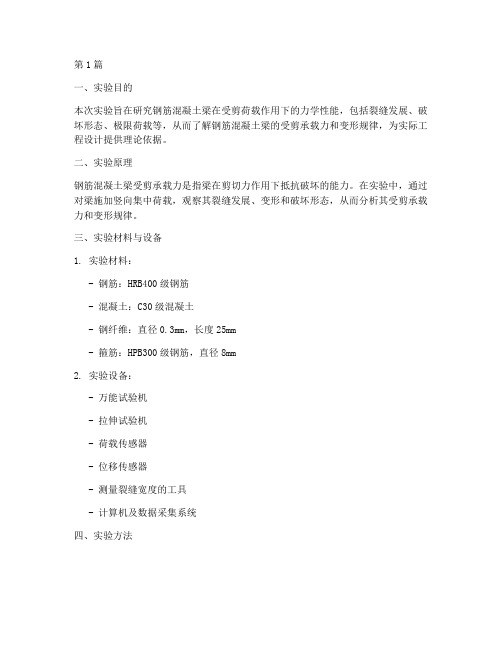
第1篇一、实验目的本次实验旨在研究钢筋混凝土梁在受剪荷载作用下的力学性能,包括裂缝发展、破坏形态、极限荷载等,从而了解钢筋混凝土梁的受剪承载力和变形规律,为实际工程设计提供理论依据。
二、实验原理钢筋混凝土梁受剪承载力是指梁在剪切力作用下抵抗破坏的能力。
在实验中,通过对梁施加竖向集中荷载,观察其裂缝发展、变形和破坏形态,从而分析其受剪承载力和变形规律。
三、实验材料与设备1. 实验材料:- 钢筋:HRB400级钢筋- 混凝土:C30级混凝土- 钢纤维:直径0.3mm,长度25mm- 箍筋:HPB300级钢筋,直径8mm2. 实验设备:- 万能试验机- 拉伸试验机- 荷载传感器- 位移传感器- 测量裂缝宽度的工具- 计算机及数据采集系统四、实验方法1. 试件制作:按照设计要求,制作6根钢筋混凝土梁试件,尺寸为150mm×150mm×600mm,梁高与跨径之比为1:4。
在梁中部设置集中荷载点,并在梁的两侧布置箍筋,箍筋间距为100mm。
2. 实验加载:将试件放置在万能试验机上,施加竖向集中荷载,荷载以5kN/min的速率均匀增加,直至试件破坏。
3. 数据采集:在实验过程中,记录荷载、位移、裂缝宽度等数据,并通过数据采集系统实时传输至计算机。
五、实验结果与分析1. 裂缝发展:实验过程中,梁中部荷载点附近出现斜裂缝,随着荷载的增加,裂缝逐渐扩展,直至试件破坏。
2. 破坏形态:试件破坏时,斜裂缝贯穿整个梁截面,箍筋屈服,混凝土剥落。
3. 极限荷载:试件破坏时的荷载为极限荷载,计算得出钢筋混凝土梁的受剪承载力。
4. 变形规律:实验过程中,梁的挠度随着荷载的增加而逐渐增大,直至试件破坏。
六、结论1. 钢筋混凝土梁在受剪荷载作用下,斜裂缝是主要的破坏形式。
2. 钢筋混凝土梁的受剪承载力与混凝土强度、箍筋直径、箍筋间距等因素有关。
3. 实验结果与理论计算基本吻合,为实际工程设计提供了理论依据。
七、建议1. 在实际工程设计中,应根据工程要求选择合适的混凝土强度等级和箍筋直径。
混凝土梁抗剪试验方法

混凝土梁抗剪试验方法一、试验目的混凝土梁抗剪试验是为了评价混凝土结构构件的抗剪性能,对于设计和施工过程中的控制和质量检验具有重要意义。
二、试验原理混凝土梁抗剪试验采用剪力作用的方式进行,即应用水平剪力使混凝土梁产生破坏。
试验中,梁的两端固定,施加垂直于梁轴线的荷载,使梁受到弯曲力和剪力的共同作用。
在荷载作用下,混凝土梁内部会发生剪切破坏,从而评价混凝土梁的抗剪性能。
三、试验设备和材料1. 试验设备:(1)混凝土梁抗剪试验机:能够施加水平剪力的试验机,能够测量剪力和位移。
(2)测力传感器:用于测量试验机施加的荷载大小。
(3)位移传感器:用于测量试验过程中混凝土梁的变形。
2. 试验材料:(1)混凝土:按照规范要求配制的混凝土。
(2)钢筋:按照规范要求加工的钢筋。
四、试验准备1. 模具制作:按照规范要求制作混凝土梁的模具。
2. 混凝土制备:按照规范要求配制混凝土。
3. 钢筋加工:按照规范要求加工钢筋。
4. 模具安装:将制作好的模具放在试验机上,用蝴蝶螺母固定。
5. 钢筋安装:按照规范要求将钢筋放入模具中。
6. 混凝土浇筑:将已配制好的混凝土倒入模具中。
7. 模具拆卸:等待混凝土充分凝固,拆卸模具。
五、试验步骤1. 安装试验梁:将制作好的混凝土梁放在试验机上,两端固定。
2. 调整试验机:根据试验梁的尺寸和试验要求,调整试验机的参数。
3. 施加荷载:通过试验机施加水平剪力,使混凝土梁受到弯曲力和剪力的共同作用。
4. 监测数据:记录试验过程中的荷载大小和混凝土梁的位移。
5. 停止试验:当混凝土梁发生破坏或达到规定的试验荷载时,停止试验。
六、试验结果分析通过试验得到的数据,可以计算出混凝土梁的极限剪应力、抗剪强度等参数。
根据试验结果,可以评价混凝土梁的抗剪性能,为混凝土结构的设计和施工提供参考。
七、试验注意事项1. 混凝土梁的制作和试验应按照规范要求进行。
2. 试验前应检查试验设备和材料的状态,确保其正常运行。
钢筋混凝土梁的抗剪性能试验研究
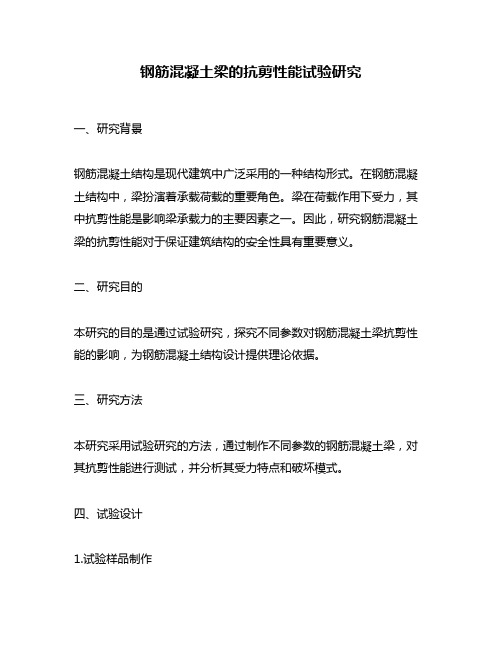
钢筋混凝土梁的抗剪性能试验研究一、研究背景钢筋混凝土结构是现代建筑中广泛采用的一种结构形式。
在钢筋混凝土结构中,梁扮演着承载荷载的重要角色。
梁在荷载作用下受力,其中抗剪性能是影响梁承载力的主要因素之一。
因此,研究钢筋混凝土梁的抗剪性能对于保证建筑结构的安全性具有重要意义。
二、研究目的本研究的目的是通过试验研究,探究不同参数对钢筋混凝土梁抗剪性能的影响,为钢筋混凝土结构设计提供理论依据。
三、研究方法本研究采用试验研究的方法,通过制作不同参数的钢筋混凝土梁,对其抗剪性能进行测试,并分析其受力特点和破坏模式。
四、试验设计1.试验样品制作本次试验制作的钢筋混凝土梁为T型梁,其截面尺寸为200mm×300mm,长度为1000mm。
在制作过程中,使用混凝土强度等级为C30、钢筋品种为HRB400的材料。
2.试验参数设置本次试验设置了以下参数:(1)纵向钢筋直径:10mm、12mm、14mm(2)箍筋间距:100mm、150mm、200mm(3)箍筋直径:6mm、8mm、10mm设置以上参数的目的是探究不同参数对钢筋混凝土梁抗剪性能的影响。
3.试验方法本次试验采用四点弯曲试验法,按照GB/T50081-2002《混凝土结构设计规范》的要求进行。
试验过程中记录梁的位移、载荷等数据,以便后续分析。
五、试验结果分析1.梁的受力特点试验结果显示,随着纵向钢筋直径的增加,梁的承载力逐渐增加;随着箍筋间距的增加,梁的承载力逐渐降低;随着箍筋直径的增加,梁的承载力逐渐增加。
2.梁的破坏模式试验结果显示,在大多数样品中,梁的破坏模式为剪切破坏。
在一些样品中,还出现了箍筋断裂和钢筋拉断等破坏形式。
六、结论本次试验研究了不同参数对钢筋混凝土梁抗剪性能的影响,并得出以下结论:(1)随着纵向钢筋直径的增加,梁的承载力逐渐增加;(2)随着箍筋间距的增加,梁的承载力逐渐降低;(3)随着箍筋直径的增加,梁的承载力逐渐增加;(4)大多数样品中,梁的破坏模式为剪切破坏,还出现了箍筋断裂和钢筋拉断等破坏形式。
混凝土梁的剪切试验标准
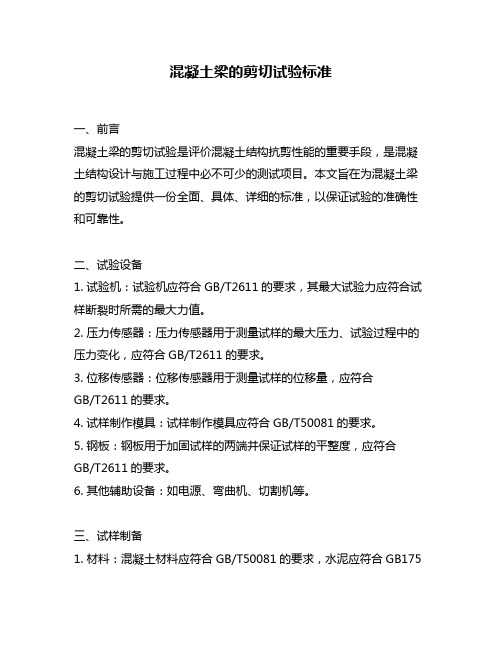
混凝土梁的剪切试验标准一、前言混凝土梁的剪切试验是评价混凝土结构抗剪性能的重要手段,是混凝土结构设计与施工过程中必不可少的测试项目。
本文旨在为混凝土梁的剪切试验提供一份全面、具体、详细的标准,以保证试验的准确性和可靠性。
二、试验设备1. 试验机:试验机应符合GB/T2611的要求,其最大试验力应符合试样断裂时所需的最大力值。
2. 压力传感器:压力传感器用于测量试样的最大压力、试验过程中的压力变化,应符合GB/T2611的要求。
3. 位移传感器:位移传感器用于测量试样的位移量,应符合GB/T2611的要求。
4. 试样制作模具:试样制作模具应符合GB/T50081的要求。
5. 钢板:钢板用于加固试样的两端并保证试样的平整度,应符合GB/T2611的要求。
6. 其他辅助设备:如电源、弯曲机、切割机等。
三、试样制备1. 材料:混凝土材料应符合GB/T50081的要求,水泥应符合GB175的要求。
2. 模具:模具应符合GB/T50081的要求,表面应光滑平整。
3. 制备:按照GB/T50081的要求制备试样,试样的尺寸应符合试验标准的要求。
4. 养护:试样的养护应符合GB/T50081的要求。
四、试验方法1. 试验前准备:(1)检查试验机、传感器等设备是否正常。
(2)检查试样的尺寸是否符合试验标准的要求。
(3)将试样放入钢板中夹紧并固定在试验机的夹持装置中。
2. 试验条件:(1)试验温度应在20℃±2℃。
(2)试验湿度应在60%±5%。
(3)试验速度应符合试验标准的要求。
3. 试验过程:(1)在试验机上设置试验参数。
(2)启动试验机,进行试验。
(3)在试验过程中记录试样的最大力值、位移量和压力变化等数据。
(4)试验结束后,将试样取出并进行观察和记录。
4. 试验结果处理:(1)计算试样的极限剪应力和抗剪强度。
(2)对试验数据进行统计分析,生成试验报告。
五、试验结果判定1. 极限剪应力的计算:极限剪应力τc的计算公式为:τc=Pmax/bd其中,Pmax为试样的最大力值,b为试样的宽度,d为试样的高度。
混凝土梁剪切强度标准值
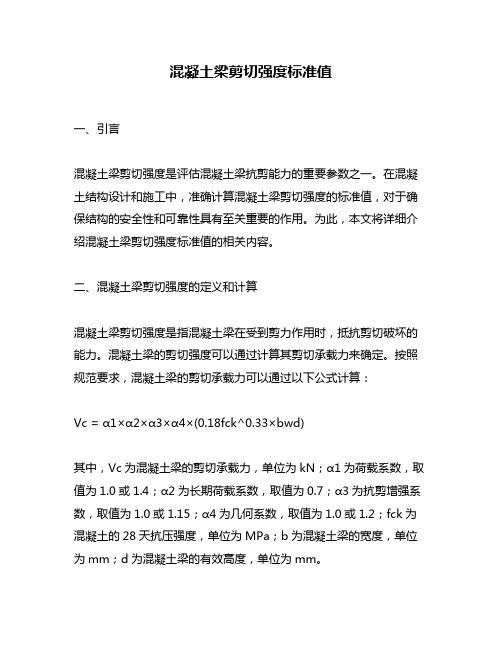
混凝土梁剪切强度标准值一、引言混凝土梁剪切强度是评估混凝土梁抗剪能力的重要参数之一。
在混凝土结构设计和施工中,准确计算混凝土梁剪切强度的标准值,对于确保结构的安全性和可靠性具有至关重要的作用。
为此,本文将详细介绍混凝土梁剪切强度标准值的相关内容。
二、混凝土梁剪切强度的定义和计算混凝土梁剪切强度是指混凝土梁在受到剪力作用时,抵抗剪切破坏的能力。
混凝土梁的剪切强度可以通过计算其剪切承载力来确定。
按照规范要求,混凝土梁的剪切承载力可以通过以下公式计算:Vc = α1×α2×α3×α4×(0.18fck^0.33×bwd)其中,Vc为混凝土梁的剪切承载力,单位为kN;α1为荷载系数,取值为1.0或1.4;α2为长期荷载系数,取值为0.7;α3为抗剪增强系数,取值为1.0或1.15;α4为几何系数,取值为1.0或1.2;fck为混凝土的28天抗压强度,单位为MPa;b为混凝土梁的宽度,单位为mm;d为混凝土梁的有效高度,单位为mm。
根据上述公式,混凝土梁剪切强度的标准值受到多个因素的影响,需要根据具体设计条件进行计算。
三、混凝土梁剪切强度标准值的相关规范在混凝土结构设计和施工中,混凝土梁的剪切强度标准值需要参考相关规范进行计算。
目前,国内外常用的混凝土结构设计规范包括中国建筑标准设计规范、美国混凝土设计规范、欧洲混凝土设计规范等。
1. 中国建筑标准设计规范中国建筑标准设计规范中对于混凝土梁的剪切强度标准值的计算,采用了以上提到的公式。
其中,荷载系数α1的取值根据混凝土梁的荷载类型和荷载性质而定。
长期荷载系数α2为0.7,抗剪增强系数α3按照混凝土梁的钢筋配筋情况确定,几何系数α4根据混凝土梁的形状而定。
2. 美国混凝土设计规范美国混凝土设计规范中,混凝土梁的剪切强度标准值的计算采用了不同的公式。
具体而言,美国混凝土设计规范中将混凝土梁剪切强度标准值分为两类:桥梁和非桥梁。
混凝土梁剪切强度标准
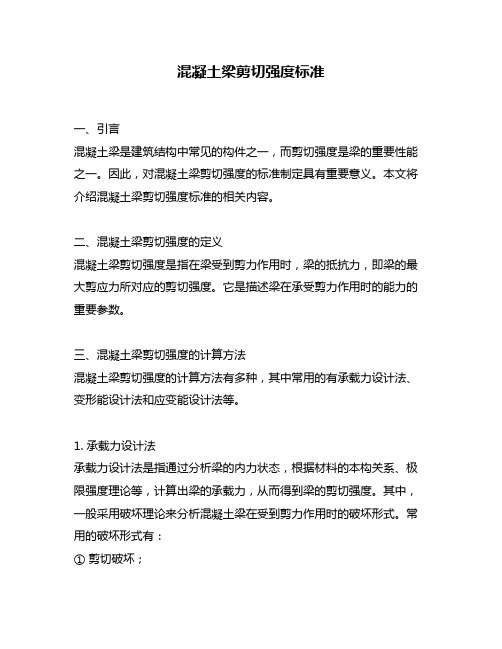
混凝土梁剪切强度标准一、引言混凝土梁是建筑结构中常见的构件之一,而剪切强度是梁的重要性能之一。
因此,对混凝土梁剪切强度的标准制定具有重要意义。
本文将介绍混凝土梁剪切强度标准的相关内容。
二、混凝土梁剪切强度的定义混凝土梁剪切强度是指在梁受到剪力作用时,梁的抵抗力,即梁的最大剪应力所对应的剪切强度。
它是描述梁在承受剪力作用时的能力的重要参数。
三、混凝土梁剪切强度的计算方法混凝土梁剪切强度的计算方法有多种,其中常用的有承载力设计法、变形能设计法和应变能设计法等。
1. 承载力设计法承载力设计法是指通过分析梁的内力状态,根据材料的本构关系、极限强度理论等,计算出梁的承载力,从而得到梁的剪切强度。
其中,一般采用破坏理论来分析混凝土梁在受到剪力作用时的破坏形式。
常用的破坏形式有:① 剪切破坏;② 梁的翻转破坏;③ 剪切破坏和梁的翻转破坏同时出现。
2. 变形能设计法变形能设计法是指通过分析梁的内力状态,根据材料的本构关系、应变能理论等,计算出梁的变形能,从而得到梁的剪切强度。
其中,应变能理论是指材料在受力过程中所吸收的能量,即应变能。
3. 应变能设计法应变能设计法是指通过分析梁的内力状态,根据材料的本构关系、应变能理论等,计算出梁的应变能,从而得到梁的剪切强度。
其中,应变能理论是指材料在受力过程中所吸收的能量,即应变能。
四、混凝土梁剪切强度的标准混凝土梁剪切强度的标准主要有两种,即国际标准和国家标准。
1. 国际标准目前,国际上常用的混凝土梁剪切强度标准有:① ASTM标准:美国材料和试验协会制定的标准;② BS标准:英国标准;③ DIN标准:德国标准;④ JIS标准:日本工业标准。
2. 国家标准我国目前常用的混凝土梁剪切强度标准有:① JGJ/T 23-2011《建筑结构混凝土结构设计规范》;② GB50010-2010《混凝土结构设计规范》。
五、混凝土梁剪切强度标准的具体要求混凝土梁剪切强度标准的具体要求包括以下几个方面:1. 材料要求混凝土梁剪切强度标准中对混凝土和钢筋等材料的要求包括:混凝土强度等级、钢筋强度等级、混凝土骨架的抗拉强度、混凝土的抗压强度、混凝土的抗剪强度、混凝土的变形性能等。
混凝土梁受剪承载力试验技术规程

混凝土梁受剪承载力试验技术规程一、引言混凝土梁受剪试验是评估混凝土结构抗剪性能的重要手段之一,其结果可用于设计和验算混凝土结构。
本技术规程旨在规范混凝土梁受剪试验的操作步骤、要求及试验结果的处理方法。
二、试验设备及材料1. 试验设备:负荷试验机、应变测量系统、位移测量系统。
2. 试验材料:混凝土、钢筋、应变计。
三、试验前准备1. 结构设计:根据试验要求设计混凝土梁的结构尺寸、钢筋配筋、施工要求等。
2. 材料准备:购买或自行配制混凝土、钢筋、应变计,并按要求进行标识。
3. 构件制作:按设计要求制作混凝土梁,保证尺寸、配筋、浇筑质量等符合要求。
4. 室内养护:混凝土梁浇筑后,应进行室内养护,确保其强度达到试验要求。
四、试验操作步骤1. 安装试件:将混凝土梁放置在试验机上,按设计要求进行支撑。
2. 安装应变计:在混凝土梁上安装应变计,测量混凝土梁的应变变化。
3. 施加荷载:按设计要求施加荷载,记录荷载与位移的变化。
4. 观察裂缝:在试验过程中,观察混凝土梁的裂缝情况,并记录。
5. 停止试验:当混凝土梁出现失稳或破坏时,停止试验,记录此时的荷载与位移。
五、试验结果处理1. 计算破坏荷载:将试验中最大荷载记录为破坏荷载。
2. 计算极限剪应力:根据试验数据,计算混凝土梁的极限剪应力,公式如下:τ = P / (b·h)其中,τ为极限剪应力,P为破坏荷载,b为混凝土梁的宽度,h为混凝土梁的高度。
3. 绘制荷载-位移曲线:根据试验数据,绘制荷载-位移曲线,观察混凝土梁的变形性能。
4. 分析试验结果:根据试验结果,评估混凝土梁的抗剪性能是否符合设计要求。
六、注意事项1. 试验过程中应注意安全,避免人员和设备受到伤害。
2. 试验前应确保试件的尺寸、配筋、浇筑质量等符合设计要求。
3. 应变计的安装应准确无误,避免影响试验结果。
4. 试验数据应记录准确无误,避免影响试验结果。
5. 试验结束后,应及时清理试验设备和试件,保证下次试验的准确性。
混凝土抗剪强度测试方法与标准
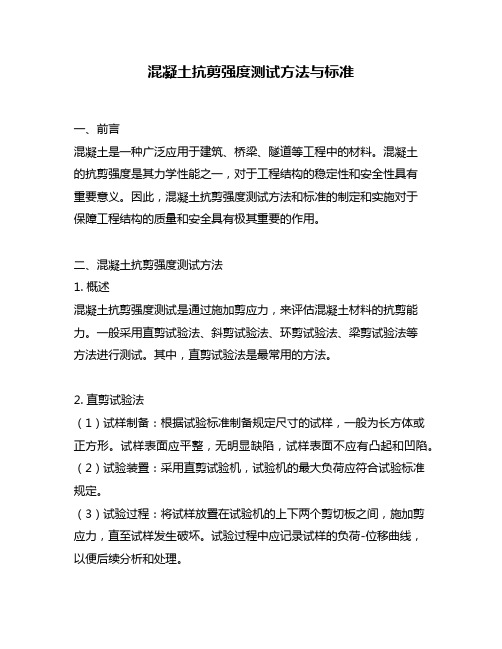
混凝土抗剪强度测试方法与标准一、前言混凝土是一种广泛应用于建筑、桥梁、隧道等工程中的材料。
混凝土的抗剪强度是其力学性能之一,对于工程结构的稳定性和安全性具有重要意义。
因此,混凝土抗剪强度测试方法和标准的制定和实施对于保障工程结构的质量和安全具有极其重要的作用。
二、混凝土抗剪强度测试方法1. 概述混凝土抗剪强度测试是通过施加剪应力,来评估混凝土材料的抗剪能力。
一般采用直剪试验法、斜剪试验法、环剪试验法、梁剪试验法等方法进行测试。
其中,直剪试验法是最常用的方法。
2. 直剪试验法(1)试样制备:根据试验标准制备规定尺寸的试样,一般为长方体或正方形。
试样表面应平整,无明显缺陷,试样表面不应有凸起和凹陷。
(2)试验装置:采用直剪试验机,试验机的最大负荷应符合试验标准规定。
(3)试验过程:将试样放置在试验机的上下两个剪切板之间,施加剪应力,直至试样发生破坏。
试验过程中应记录试样的负荷-位移曲线,以便后续分析和处理。
3. 斜剪试验法(1)试样制备:根据试验标准制备规定尺寸的试样,试样的边缘应圆滑,试样表面应平整,无明显缺陷。
(2)试验装置:采用斜剪试验机,试验机的最大负荷应符合试验标准规定。
(3)试验过程:将试样放置在试验机的上下两个剪切板之间,施加剪应力,直至试样发生破坏。
试验过程中应记录试样的负荷-位移曲线,以便后续分析和处理。
4. 环剪试验法(1)试样制备:根据试验标准制备规定尺寸的试样,试样表面应平整,无明显缺陷。
(2)试验装置:采用环剪试验机,试验机的最大负荷应符合试验标准规定。
(3)试验过程:将试样放置在环形剪切板上,施加剪应力,直至试样发生破坏。
试验过程中应记录试样的负荷-位移曲线,以便后续分析和处理。
5. 梁剪试验法(1)试样制备:根据试验标准制备规定尺寸的试样,试样表面应平整,无明显缺陷。
(2)试验装置:采用梁剪试验机,试验机的最大负荷应符合试验标准规定。
(3)试验过程:将试样放置在梁剪试验机上,施加剪应力,直至试样发生破坏。
混凝土梁剪切强度标准
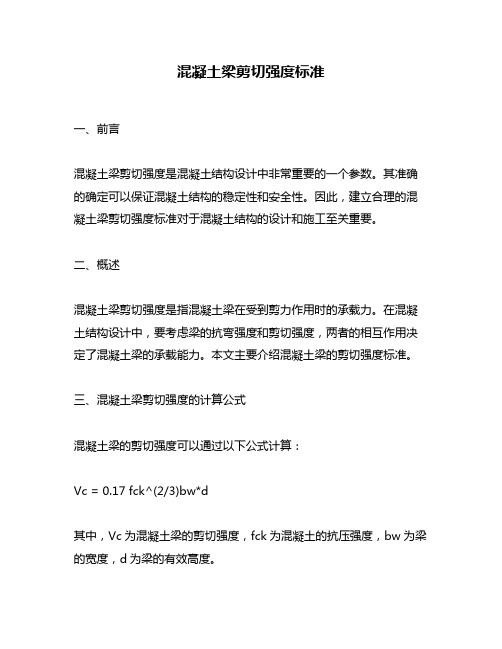
混凝土梁剪切强度标准一、前言混凝土梁剪切强度是混凝土结构设计中非常重要的一个参数。
其准确的确定可以保证混凝土结构的稳定性和安全性。
因此,建立合理的混凝土梁剪切强度标准对于混凝土结构的设计和施工至关重要。
二、概述混凝土梁剪切强度是指混凝土梁在受到剪力作用时的承载力。
在混凝土结构设计中,要考虑梁的抗弯强度和剪切强度,两者的相互作用决定了混凝土梁的承载能力。
本文主要介绍混凝土梁的剪切强度标准。
三、混凝土梁剪切强度的计算公式混凝土梁的剪切强度可以通过以下公式计算:Vc = 0.17 fck^(2/3)bw*d其中,Vc为混凝土梁的剪切强度,fck为混凝土的抗压强度,bw为梁的宽度,d为梁的有效高度。
四、混凝土梁剪切强度的标准根据国家标准《建筑结构荷载规范》(GB 50009-2012),混凝土梁的剪切强度应满足以下要求:1.混凝土梁的剪切强度应大于或等于剪力的设计值;2.混凝土梁的剪切强度的计算值应满足下列公式:Vc >= VEd其中,Vc为混凝土梁的剪切强度,VEd为混凝土梁承受的剪力设计值。
3.混凝土梁的设计剪切强度应在以下范围内进行选择:0.18fck^(2/3) <= Vc <= 0.55fck^(1/2)其中,fck为混凝土的抗压强度。
4.当混凝土梁的剪切跨度比超过2时,应按以下公式计算剪切强度:Vc = 0.27fck^(2/3)bw*d其中,fck为混凝土的抗压强度,bw为梁的宽度,d为梁的有效高度。
五、混凝土梁剪切强度的影响因素混凝土梁的剪切强度受到多种因素的影响,主要包括以下几点:1.混凝土的抗压强度;2.梁的宽度和高度;3.钢筋的数量和分布;4.剪跨比和受力状态。
六、混凝土梁剪切强度的检验方法混凝土梁剪切强度的检验方法主要有以下几种:1.钢筋拉出试验法:在混凝土梁中埋入钢筋,然后通过拉拔钢筋来检验混凝土梁的剪切强度。
2.梁的剪切试验法:将混凝土梁放置在试验机上,施加剪力来检验混凝土梁的剪切强度。
混凝土梁的抗剪强度标准
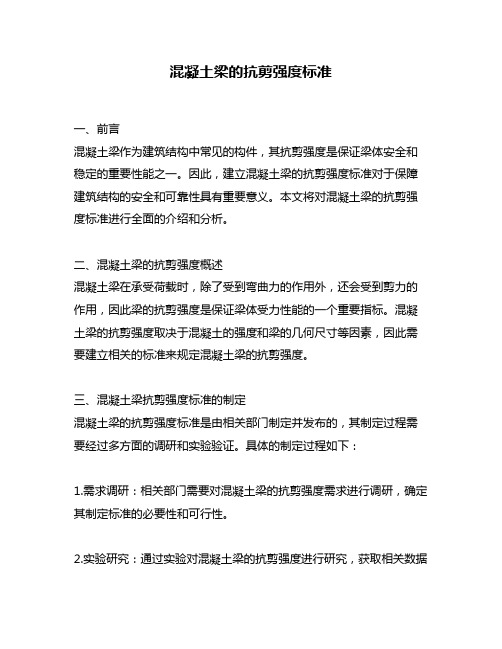
混凝土梁的抗剪强度标准一、前言混凝土梁作为建筑结构中常见的构件,其抗剪强度是保证梁体安全和稳定的重要性能之一。
因此,建立混凝土梁的抗剪强度标准对于保障建筑结构的安全和可靠性具有重要意义。
本文将对混凝土梁的抗剪强度标准进行全面的介绍和分析。
二、混凝土梁的抗剪强度概述混凝土梁在承受荷载时,除了受到弯曲力的作用外,还会受到剪力的作用,因此梁的抗剪强度是保证梁体受力性能的一个重要指标。
混凝土梁的抗剪强度取决于混凝土的强度和梁的几何尺寸等因素,因此需要建立相关的标准来规定混凝土梁的抗剪强度。
三、混凝土梁抗剪强度标准的制定混凝土梁的抗剪强度标准是由相关部门制定并发布的,其制定过程需要经过多方面的调研和实验验证。
具体的制定过程如下:1.需求调研:相关部门需要对混凝土梁的抗剪强度需求进行调研,确定其制定标准的必要性和可行性。
2.实验研究:通过实验对混凝土梁的抗剪强度进行研究,获取相关数据并进行分析。
3.标准制定:根据实验数据和需求调研结果,制定相关标准,包括抗剪强度计算公式、试验方法等内容。
4.标准发布:经过专家评审和相关部门审核,将标准正式发布并实施。
四、混凝土梁抗剪强度标准的内容混凝土梁抗剪强度标准的内容包括抗剪强度计算公式、试验方法和抗剪强度设计值等。
具体内容如下:1.抗剪强度计算公式:混凝土梁的抗剪强度计算公式是标准中最重要的内容之一。
目前国内常用的计算公式有剪力设计值法、剪跨比法和剪力平衡法等。
2.试验方法:混凝土梁抗剪强度的试验方法包括梁的加荷方式、荷载大小和荷载持续时间等,需要在标准中进行详细规定。
3.抗剪强度设计值:混凝土梁的抗剪强度设计值是标准中规定的混凝土梁在设计时所需满足的抗剪强度指标。
其设计值需要根据公式和试验数据进行计算。
五、混凝土梁抗剪强度标准的实施混凝土梁抗剪强度标准的实施需要遵循相关的程序和规定。
具体的实施步骤如下:1.标准宣传:相关部门需要对标准进行宣传,让建筑业界和公众了解和认识标准的重要性和意义。
混凝土梁的受剪承载力设计标准
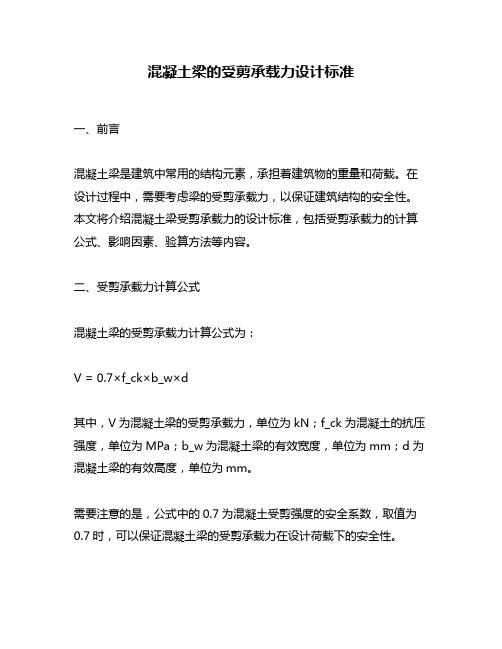
混凝土梁的受剪承载力设计标准一、前言混凝土梁是建筑中常用的结构元素,承担着建筑物的重量和荷载。
在设计过程中,需要考虑梁的受剪承载力,以保证建筑结构的安全性。
本文将介绍混凝土梁受剪承载力的设计标准,包括受剪承载力的计算公式、影响因素、验算方法等内容。
二、受剪承载力计算公式混凝土梁的受剪承载力计算公式为:V = 0.7×f_ck×b_w×d其中,V为混凝土梁的受剪承载力,单位为kN;f_ck为混凝土的抗压强度,单位为MPa;b_w为混凝土梁的有效宽度,单位为mm;d为混凝土梁的有效高度,单位为mm。
需要注意的是,公式中的0.7为混凝土受剪强度的安全系数,取值为0.7时,可以保证混凝土梁的受剪承载力在设计荷载下的安全性。
三、影响因素混凝土梁的受剪承载力受以下因素影响:1. 混凝土的抗压强度:混凝土的强度越高,受剪承载力也越大。
2. 混凝土梁的宽度和高度:混凝土梁的有效宽度和高度越大,受剪承载力也越大。
3. 钢筋的配筋率:钢筋的配筋率越高,混凝土梁的受剪承载力也越大。
4. 混凝土梁的跨度和荷载:混凝土梁的跨度和荷载越大,受剪承载力也越大。
四、验算方法混凝土梁的受剪承载力验算方法包括强度验算和变形验算两种。
1. 强度验算:强度验算主要是指混凝土梁的抗剪强度是否大于设计荷载下的受剪荷载。
当混凝土梁的抗剪强度大于设计荷载下的受剪荷载时,混凝土梁的受剪承载力是安全的。
2. 变形验算:变形验算主要是指混凝土梁在受剪荷载作用下的变形是否符合要求。
当混凝土梁的变形量小于允许值时,混凝土梁的受剪承载力也是安全的。
五、设计标准混凝土梁的受剪承载力设计标准主要包括以下几个方面:1. 混凝土的抗压强度应符合设计要求,一般按照混凝土标号分类。
2. 混凝土梁的有效宽度和高度应根据实际情况确定,一般应考虑梁的截面形状和钢筋的布置情况。
3. 钢筋的配筋率应符合设计要求,一般按照混凝土标号和受力状态分类。
混凝土梁的抗剪试验标准
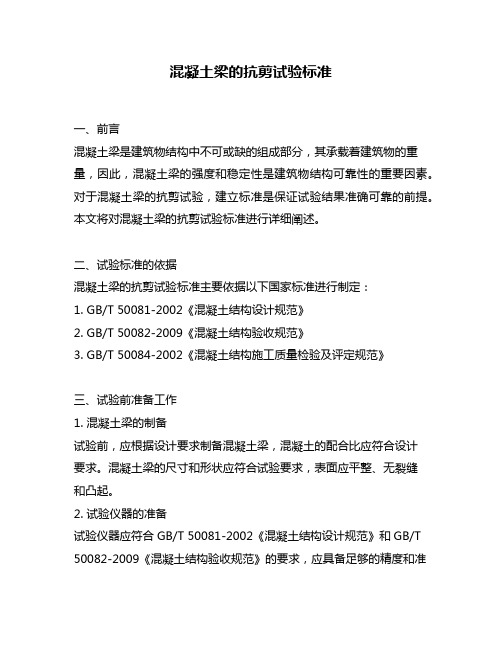
混凝土梁的抗剪试验标准一、前言混凝土梁是建筑物结构中不可或缺的组成部分,其承载着建筑物的重量,因此,混凝土梁的强度和稳定性是建筑物结构可靠性的重要因素。
对于混凝土梁的抗剪试验,建立标准是保证试验结果准确可靠的前提。
本文将对混凝土梁的抗剪试验标准进行详细阐述。
二、试验标准的依据混凝土梁的抗剪试验标准主要依据以下国家标准进行制定:1. GB/T 50081-2002《混凝土结构设计规范》2. GB/T 50082-2009《混凝土结构验收规范》3. GB/T 50084-2002《混凝土结构施工质量检验及评定规范》三、试验前准备工作1. 混凝土梁的制备试验前,应根据设计要求制备混凝土梁,混凝土的配合比应符合设计要求。
混凝土梁的尺寸和形状应符合试验要求,表面应平整、无裂缝和凸起。
2. 试验仪器的准备试验仪器应符合GB/T 50081-2002《混凝土结构设计规范》和GB/T 50082-2009《混凝土结构验收规范》的要求,应具备足够的精度和准确性。
试验仪器应在试验前进行校准和验收。
3. 试验环境的准备试验室应保持恒温恒湿的环境,温度应在20℃±2℃之间,相对湿度应在60%±5%之间。
试验室应保持安静,避免外界干扰。
四、试验步骤1. 安装试验仪器将混凝土梁放置在试验台上,调整试验仪器的位置和角度,使其与混凝土梁完全贴合,并保证试验仪器的稳定性和准确性。
2. 施加试验荷载根据设计要求和试验目的,施加试验荷载。
荷载施加应分段进行,每个荷载阶段应保持稳定,荷载速度应缓慢,以避免混凝土梁产生剪切破坏。
3. 记录试验数据在试验过程中,应记录试验数据,包括荷载变化、变形情况、试验时间等,以便后续数据分析和评估。
4. 试验结束当混凝土梁产生剪切破坏或达到设计荷载时,试验结束。
记录并分析试验数据,评估试验结果的可靠性和准确性。
五、试验结果的评估1. 构造试验曲线通过试验记录的荷载变化和变形情况,构造试验曲线。
混凝土梁的剪切性能测试方法及标准
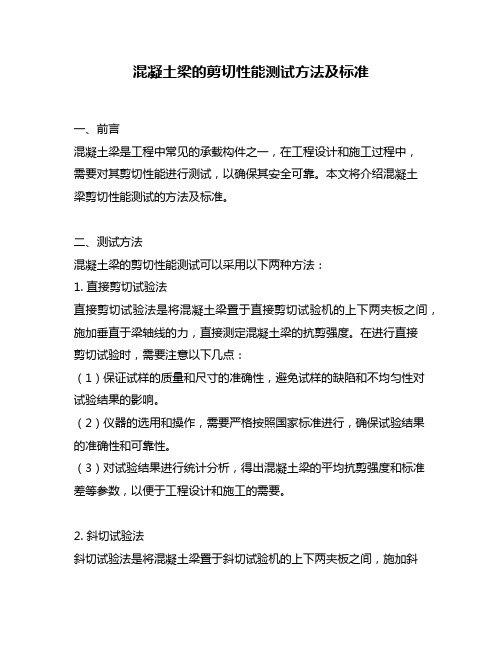
混凝土梁的剪切性能测试方法及标准一、前言混凝土梁是工程中常见的承载构件之一,在工程设计和施工过程中,需要对其剪切性能进行测试,以确保其安全可靠。
本文将介绍混凝土梁剪切性能测试的方法及标准。
二、测试方法混凝土梁的剪切性能测试可以采用以下两种方法:1. 直接剪切试验法直接剪切试验法是将混凝土梁置于直接剪切试验机的上下两夹板之间,施加垂直于梁轴线的力,直接测定混凝土梁的抗剪强度。
在进行直接剪切试验时,需要注意以下几点:(1)保证试样的质量和尺寸的准确性,避免试样的缺陷和不均匀性对试验结果的影响。
(2)仪器的选用和操作,需要严格按照国家标准进行,确保试验结果的准确性和可靠性。
(3)对试验结果进行统计分析,得出混凝土梁的平均抗剪强度和标准差等参数,以便于工程设计和施工的需要。
2. 斜切试验法斜切试验法是将混凝土梁置于斜切试验机的上下两夹板之间,施加斜向的力,测定混凝土梁的弹性模量和抗剪强度。
在进行斜切试验时,需要注意以下几点:(1)试样的制备和尺寸的准确性,需要按照相应的标准进行,以保证试验结果的准确性。
(2)斜切试验机的选用和操作,需要严格按照国家标准进行,确保试验结果的可靠性和准确性。
(3)对试验结果进行统计分析,得出混凝土梁的弹性模量和抗剪强度等参数,以便于工程设计和施工的需要。
三、标准规范混凝土梁的剪切性能测试需要遵循以下国家标准:1. GB/T 50081-2002《建筑结构试验方法标准》该标准规定了混凝土梁的剪切性能测试的试验方法和技术要求,包括试样的准备、试验机的选用和操作、试验过程中的注意事项等,保证了试验结果的准确性和可靠性。
2. JGJ/T 23-2011《混凝土结构工程验收规范》该规范对混凝土结构工程的验收进行了系统的规范,其中包括了混凝土梁的剪切性能测试和验收标准,保证了混凝土梁的安全性和可靠性。
3. CJJ/T 23-2011《建筑结构抗震设计规范》该规范对建筑结构的抗震设计进行了系统的规范,其中包括了混凝土梁的剪切性能测试和验收标准,保证了建筑结构的抗震性能和安全性。
美国ACI钢筋混凝土结构设计方法(三)——梁的抗剪强度计算
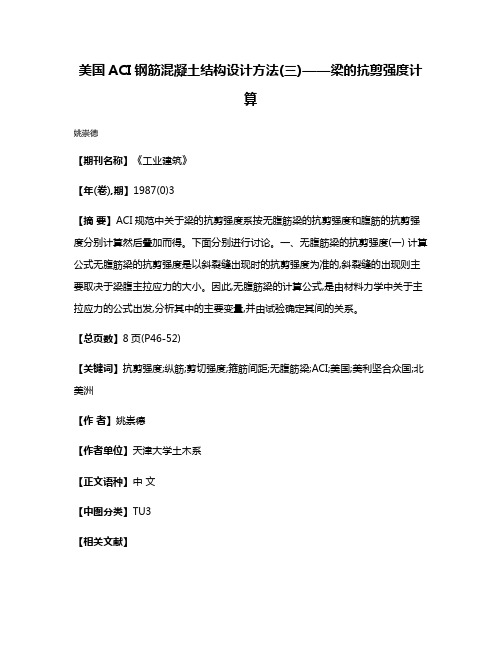
美国ACI钢筋混凝土结构设计方法(三)——梁的抗剪强度计
算
姚崇德
【期刊名称】《工业建筑》
【年(卷),期】1987(0)3
【摘要】ACI规范中关于梁的抗剪强度系按无腹筋梁的抗剪强度和腹筋的抗剪强度分别计算然后叠加而得。
下面分别进行讨论。
一、无腹筋梁的抗剪强度(一) 计算公式无腹筋梁的抗剪强度是以斜裂缝出现时的抗剪强度为准的,斜裂缝的出现则主要取决于梁腹主拉应力的大小。
因此,无腹筋梁的计算公式,是由材料力学中关于主拉应力的公式出发,分析其中的主要变量,并由试验确定其间的关系。
【总页数】8页(P46-52)
【关键词】抗剪强度;纵筋;剪切强度;箍筋间距;无腹筋梁;ACI;美国;美利坚合众国;北美洲
【作者】姚崇德
【作者单位】天津大学土木系
【正文语种】中文
【中图分类】TU3
【相关文献】
1.我国规范中钢筋混凝土梁抗剪强度计算的演变 [J], 伍坚;刘少宏
2.钢筋混凝土梁-柱-板边节点抗剪强度计算模型 [J], 邢国华;何志兵;牛荻涛;吴涛;刘喜
3.新旧规范钢筋混凝土梁抗剪强度计算公式对比 [J], 陈铭奋
4.美国ACI钢筋混凝土结构设计方法(七)——梁的抗扭强度计算 [J], 姚崇德
5.钢筋混凝土双向受弯简支梁抗剪强度简化计算 [J], 曾庆响;何高勖
因版权原因,仅展示原文概要,查看原文内容请购买。
混凝土梁剪切标准值
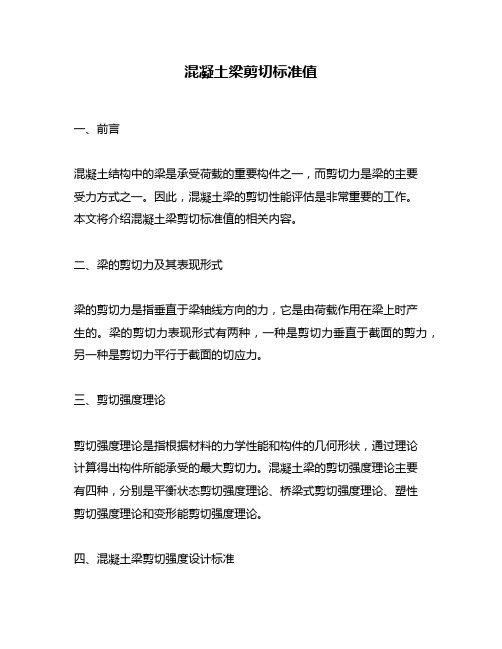
混凝土梁剪切标准值一、前言混凝土结构中的梁是承受荷载的重要构件之一,而剪切力是梁的主要受力方式之一。
因此,混凝土梁的剪切性能评估是非常重要的工作。
本文将介绍混凝土梁剪切标准值的相关内容。
二、梁的剪切力及其表现形式梁的剪切力是指垂直于梁轴线方向的力,它是由荷载作用在梁上时产生的。
梁的剪切力表现形式有两种,一种是剪切力垂直于截面的剪力,另一种是剪切力平行于截面的切应力。
三、剪切强度理论剪切强度理论是指根据材料的力学性能和构件的几何形状,通过理论计算得出构件所能承受的最大剪切力。
混凝土梁的剪切强度理论主要有四种,分别是平衡状态剪切强度理论、桥梁式剪切强度理论、塑性剪切强度理论和变形能剪切强度理论。
四、混凝土梁剪切强度设计标准混凝土梁的剪切强度设计标准是指根据国家相关标准和规范的要求,对混凝土梁的剪切强度进行设计的标准。
我国现行的混凝土结构设计规范为《混凝土结构设计规范》(GB50010-2010),其中第8章为混凝土梁的设计规范,包括剪切强度设计标准。
根据GB50010-2010规范,混凝土梁的剪切强度设计标准如下:1. 钢筋混凝土梁(1)混凝土的抗剪强度按照规范中的公式计算,计算公式如下:$$f_{v}=\frac{0.6f_{c}}{\sqrt{f_{y}}}$$其中,$f_c$为混凝土的抗压强度,$f_y$为受拉钢筋的屈服强度。
(2)钢筋混凝土梁的剪切强度取为设计荷载下的剪力和抗剪强度的较小值。
2. 预应力混凝土梁(1)预应力混凝土梁的抗剪强度按照规范中的公式计算,计算公式如下:$$f_{v}=\frac{0.6f_{c}+1.2P_{b}/A_{s}}{\sqrt{f_{y}}}$$其中,$P_b$为预应力筋的预应力,$A_s$为受拉钢筋的截面积。
(2)预应力混凝土梁的剪切强度取为设计荷载下的剪力和抗剪强度的较小值。
五、混凝土梁剪切强度验算标准混凝土梁剪切强度验算标准是指根据已知的混凝土梁的几何形状、材料性质、荷载和边界条件等参数,通过计算得到混凝土梁的剪切强度,然后与设计标准进行比较的标准。
混凝土梁的剪切承载力标准
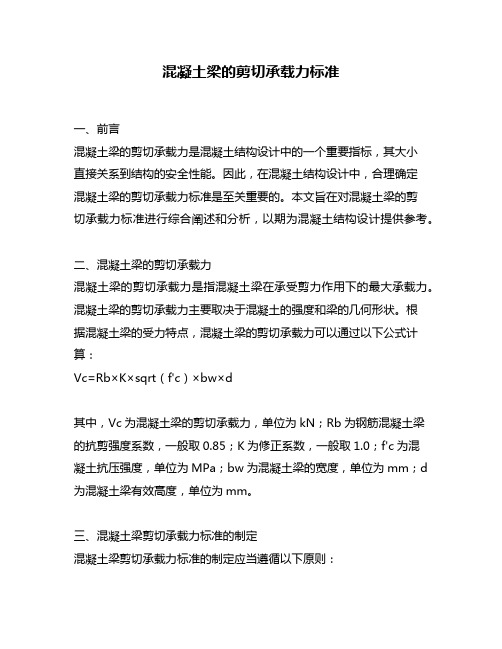
混凝土梁的剪切承载力标准一、前言混凝土梁的剪切承载力是混凝土结构设计中的一个重要指标,其大小直接关系到结构的安全性能。
因此,在混凝土结构设计中,合理确定混凝土梁的剪切承载力标准是至关重要的。
本文旨在对混凝土梁的剪切承载力标准进行综合阐述和分析,以期为混凝土结构设计提供参考。
二、混凝土梁的剪切承载力混凝土梁的剪切承载力是指混凝土梁在承受剪力作用下的最大承载力。
混凝土梁的剪切承载力主要取决于混凝土的强度和梁的几何形状。
根据混凝土梁的受力特点,混凝土梁的剪切承载力可以通过以下公式计算:Vc=Rb×K×sqrt(f'c)×bw×d其中,Vc为混凝土梁的剪切承载力,单位为kN;Rb为钢筋混凝土梁的抗剪强度系数,一般取0.85;K为修正系数,一般取1.0;f'c为混凝土抗压强度,单位为MPa;bw为混凝土梁的宽度,单位为mm;d 为混凝土梁有效高度,单位为mm。
三、混凝土梁剪切承载力标准的制定混凝土梁剪切承载力标准的制定应当遵循以下原则:1.结构安全性原则混凝土梁剪切承载力标准的制定应当保证结构的安全性能,严格控制结构在承受剪力作用下的最大载荷,以确保结构的稳定性和安全性。
2.合理性原则混凝土梁剪切承载力标准的制定应当考虑混凝土的强度和梁的几何形状等因素,合理确定梁的几何尺寸和混凝土的强度等参数,以确保标准的可行性和合理性。
3.经济性原则混凝土梁剪切承载力标准的制定应当考虑经济性因素,尽可能地降低结构的造价,并在保证结构安全性的前提下提高结构的使用寿命和可靠性。
四、混凝土梁剪切承载力标准的具体规定混凝土梁剪切承载力标准应当具有以下规定:1.混凝土抗压强度限制混凝土梁剪切承载力标准应当规定混凝土抗压强度的限制,一般情况下,混凝土抗压强度不应低于20MPa。
2.梁的几何尺寸限制混凝土梁剪切承载力标准应当规定梁的几何尺寸的限制,例如,梁的宽度不应小于150mm,梁的高度不应小于宽度的1/4。
考虑变形协调条件的钢筋混凝土无腹筋梁抗剪承载力模型化方法研究
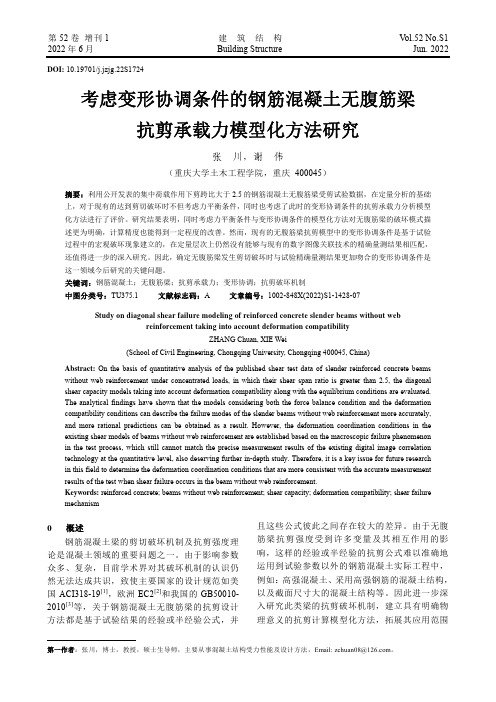
第52卷 增刊1 建筑结构 Vol.52 No.S1 2022年6月 Building Structure Jun. 2022第一作者:张川,博士,教授,硕士生导师,主要从事混凝土结构受力性能及设计方法,Email:****************。
DOI: 10.19701/j.jzjg.22S1724考虑变形协调条件的钢筋混凝土无腹筋梁抗剪承载力模型化方法研究张 川,谢 伟(重庆大学土木工程学院,重庆 400045)摘要:利用公开发表的集中荷载作用下剪跨比大于2.5的钢筋混凝土无腹筋梁受剪试验数据,在定量分析的基础上,对于现有的达到剪切破坏时不但考虑力平衡条件,同时也考虑了此时的变形协调条件的抗剪承载力分析模型化方法进行了评价。
研究结果表明,同时考虑力平衡条件与变形协调条件的模型化方法对无腹筋梁的破坏模式描述更为明确,计算精度也能得到一定程度的改善。
然而,现有的无腹筋梁抗剪模型中的变形协调条件是基于试验过程中的宏观破坏现象建立的,在定量层次上仍然没有能够与现有的数字图像关联技术的精确量测结果相匹配,还值得进一步的深入研究。
因此,确定无腹筋梁发生剪切破坏时与试验精确量测结果更加吻合的变形协调条件是这一领域今后研究的关键问题。
关键词:钢筋混凝土;无腹筋梁;抗剪承载力;变形协调;抗剪破坏机制中图分类号:TU375.1 文献标志码:A 文章编号:1002-848X(2022)S1-1428-07Study on diagonal shear failure modeling of reinforced concrete slender beams without webreinforcement taking into account deformation compatibilityZHANG Chuan, XIE Wei(School of Civil Engineering, Chongqing University, Chongqing 400045, China)Abstract: On the basis of quantitative analysis of the published shear test data of slender reinforced concrete beams without web reinforcement under concentrated loads, in which their shear span ratio is greater than 2.5, the diagonal shear capacity models taking into account deformation compatibility along with the equilibrium conditions are evaluated. The analytical findings have shown that the models considering both the force balance condition and the deformation compatibility conditions can describe the failure modes of the slender beams without web reinforcement more accurately, and more rational predictions can be obtained as a result. However, the deformation coordination conditions in the existing shear models of beams without web reinforcement are established based on the macroscopic failure phenomenon in the test process, which still cannot match the precise measurement results of the existing digital image correlation technology at the quantitative level, also deserving further in-depth study. Therefore, it is a key issue for future research in this field to determine the deformation coordination conditions that are more consistent with the accurate measurement results of the test when shear failure occurs in the beam without web reinforcement.Keywords: reinforced concrete; beams without web reinforcement; shear capacity; deformation compatibility; shear failure mechanism0 概述钢筋混凝土梁的剪切破坏机制及抗剪强度理论是混凝土领域的重要问题之一。
混凝土梁剪切标准值

混凝土梁剪切标准值1. 前言混凝土梁是建筑结构中常见的一种构件,其承受着建筑物的荷载。
在设计混凝土梁时,需要根据其受力情况来确定其尺寸和钢筋配筋。
剪切是混凝土梁中的一种重要受力形式,因此需要制定混凝土梁剪切标准值,以保证混凝土梁的安全性和可靠性。
2. 剪切的基本概念在混凝土梁中,由于施加的荷载作用于梁的上端,因此上端的混凝土受到压力,下端的混凝土受到拉力,而混凝土的强度是不同方向上的。
当荷载作用到梁的中心时,由于混凝土强度不同,会产生剪力,使梁产生剪切变形。
剪切力是指作用在混凝土梁上的力,剪切力作用在混凝土梁中心附近的梁截面上,对梁的剪切变形起主要作用。
剪切变形是指混凝土梁在受到剪切力作用下,沿截面平面内发生的变形。
剪切变形引起的混凝土压应力和拉应力,会导致混凝土梁的破坏。
3. 剪切的计算方法混凝土梁的剪切强度与混凝土的强度、钢筋的配筋率、剪跨比等因素有关。
根据混凝土梁的受力情况,可以采用以下两个公式计算混凝土梁的剪切强度:3.1 混凝土剪切强度计算公式混凝土的抗剪强度与混凝土的抗拉强度有关,可以采用以下公式计算混凝土的剪切强度:Vc = 0.15 × fcu^(1/2) × b × d其中,Vc为混凝土的剪切强度,fcu为混凝土的抗压强度,b为梁的宽度,d为梁的有效高度。
3.2 钢筋剪切强度计算公式钢筋的剪切强度与钢筋的直径、钢筋的屈服强度有关,可以采用以下公式计算钢筋的剪切强度:Vr = Asv × fyv / s其中,Vr为钢筋的剪切强度,Asv为钢筋的截面面积,fyv为钢筋的屈服强度,s为钢筋的间距。
4. 混凝土梁剪切标准值的制定混凝土梁的剪切标准值是指混凝土梁在设计和施工过程中,所能承受的最大剪切力。
混凝土梁的剪切标准值需要根据建筑物的使用性质和荷载情况、混凝土的强度等因素进行制定。
4.1 剪跨比的影响混凝土梁的剪跨比是指混凝土梁跨度与混凝土梁的有效高度之比,剪跨比对混凝土梁的剪切强度有着重要的影响。
混凝土梁的抗剪强度检测方法

混凝土梁的抗剪强度检测方法一、前言混凝土梁是建筑结构中常见的构件,其抗剪强度是梁的重要参数之一,直接关系到梁的承载能力。
本文将介绍混凝土梁的抗剪强度检测方法,帮助工程师更好地了解混凝土梁的质量。
二、混凝土梁的抗剪强度混凝土梁的抗剪强度是指梁在受到剪力作用时,能够承受的最大剪力。
混凝土的抗剪强度受到多种因素影响,如混凝土强度、受力状态、梁的几何形状等。
三、抗剪强度检测方法1. 静载试验法静载试验法是一种常用的检测混凝土梁抗剪强度的方法。
该方法需要在实验室或现场进行,需要专业的设备和技术人员。
其具体步骤如下:(1)测量梁的几何尺寸和钢筋配筋情况。
(2)安装受力梁,受力梁的长度应大于或等于测试梁的长度。
(3)在梁的两端分别安装静载器,施加等量的荷载,持续时间应大于或等于5min。
(4)记录荷载和挠度数据,并制作荷载-挠度曲线。
(5)根据荷载-挠度曲线计算混凝土梁的抗剪强度。
2. 压剪试验法压剪试验法是一种在实验室进行的检测混凝土梁抗剪强度的方法。
其具体步骤如下:(1)测量梁的几何尺寸和钢筋配筋情况。
(2)将测试梁放在压剪试验机上,使其底部受压,上端受剪。
(3)施加逐渐增加的荷载,记录每个荷载下的应变和应力。
(4)根据应力-应变曲线计算混凝土梁的抗剪强度。
3. 振动法振动法是一种在现场进行的检测混凝土梁抗剪强度的方法。
其具体步骤如下:(1)在测试梁的两端用钢丝绳吊起,保证梁与地面垂直。
(2)用锤子敲击测试梁,记录梁的自由振动周期。
(3)根据测试数据计算混凝土梁的抗剪强度。
四、注意事项1. 在进行静载试验时,应保证受力梁的长度大于或等于测试梁的长度。
2. 在进行压剪试验时,应注意梁的质量和钢筋的配筋情况,以避免实验结果的误差。
3. 在进行振动法时,应注意测试数据的准确性和可靠性。
五、结论混凝土梁的抗剪强度是梁的重要参数之一,直接关系到梁的承载能力。
静载试验法、压剪试验法和振动法是常用的检测混凝土梁抗剪强度的方法。
- 1、下载文档前请自行甄别文档内容的完整性,平台不提供额外的编辑、内容补充、找答案等附加服务。
- 2、"仅部分预览"的文档,不可在线预览部分如存在完整性等问题,可反馈申请退款(可完整预览的文档不适用该条件!)。
- 3、如文档侵犯您的权益,请联系客服反馈,我们会尽快为您处理(人工客服工作时间:9:00-18:30)。
Technical NoteEvaluation of Shear Strength Design Methodologiesfor Slender Shear-Critical RC BeamsZuanfeng Pan1and Bing Li2Abstract:This paper seeks to examine the concrete contribution to shear strength and determine the inclination of the compressive strut within the variable truss model for slender RC shear-critical beams with ing the modified compressionfield theory in place of the conven-tional statistical regression of experimental data,the expression for the concrete contribution to shear strength was derived,and the inclination of compressive struts was determined.A simplified explicit expression for shear strength was then provided,with which shear strength can be calculated without extensive iterative computations.This method was then verified using the available experimental data of209RC rectangular beams with stirrups and compared with the current methods from the American Concrete Institute and the Canadian Standards Association.The theoretical results are shown to be consistent with the experimentally observed behavior of shear-critical RC beams.DOI:10.1061/(ASCE) ST.1943-541X.0000634.©2013American Society of Civil Engineers.CE Database subject headings:Shear strength;Struts;Compression;Concrete beams;Design.Author keywords:Shear strength;Concrete contribution to shear;Inclination of strut;Modified compressionfield theory;Evaluation.IntroductionAlthough theflexural behavior of RC beams is generally well un-derstood,the explanation of shear mechanisms is relatively in-adequate.Over the last century,many researchers have managed to develop semiempirical theories based on extensive experimental data[ASCE-American Concrete Institute(ACI)Committee4261973; ASCE-ACI Committee4451998].Representative models include the limit equilibrium theory,the truss model,the strut and tie model, the plastic theory,and the shear friction theory.However,given the complexity of shear failure mechanisms,none of these theories can offer a complete explanation,and as such,there has been no unani-mously accepted theory.Recent years have seen renewed efforts to develop a theoretical model that is verified by experimental data.Many truss analogy models such as the traditional45°truss model,constant or variable angle truss model,and modified com-pressionfield theory(MCFT)(Vecchio and Collins1986)are widely used as the basis of most shear design methodologies for RC beams. The general methods in LRFD-04(AASHTO2004)and Canadian Standard-04[Canadian Standards Association(CSA)2004]are both based on ing the method in AASHTO LRFD-04,for beams with stirrups,the two factors,b and u,need to be looked up in the data charts.On the other hand,in CSA-04,it is necessary to determine the longitudinal strain at the middepth of the member using extensive iterative computations and a rough gauge of its initial value.The proposed approach in this paper is based on MCFT, rendering it unnecessary for iterative calculations or reference to data tables.The results of the proposed approach are verified using the experimental data of209RC beams with stirrups and compared with the results obtained through the methods mentioned in ACI 318R-08(ACI2008)and CSA-04(CSA2004).Shear Strength for Slender Shear-Critical RC BeamsIt is worthwhile to note that for beams with a small l or deep beams, the hypothesis that plane sections remain plane is not satisfied,and parts of the shear are directly transmitted to the supports by arch action.If the sectional shear design method is used,the results may be conservative without consideration of arch action.For RC beams with stirrups,when l$2.5,the arch action could be considered small(ASCE-ACI Committee4451998).In this paper,the present approach for shear strength based on MCFT is aimed mainly at the slender beams,which means l of the beam is$2.5,because the most practical RC beams are slender,with l ranging from approximately 2.5to6(Kassian1990;Li and Tran2008,2012).Formulas for shear strength in many codes for RC beams take into account the contribution of concrete V c and the contribution of stirrups V s.The MCFT has made an attempt to simplify the transmitting mechanism of concrete using average stresses,average strains,and local variations(Collins and Mithell1991).In the theory, the cracked concrete beam must be capable of resisting the effects of the shear,or the beam will fail before the breakdown of the ag-gregate interlock mechanism,to develop the capacity of a rough and interlocked crack interface for shear transfer.Derived by Collins and Mithell(1991),the contribution of concrete to shear isV c¼min2666640:18ffiffiffiffif0cpbd v0:31þ24ɛ1ðaþ16Þsin usþcos us x,0:33a1a2bd vffiffiffiffif0cpcot u1þffiffiffiffiffiffiffiffiffiffiffiffi500ɛ1p377775ð1ÞFrom Eq.(1),it can be seen that there are two unknowns needed to calculate shear strength:crack angle u and principal tensile strainɛ1.1Lecturer,School of Civil Engineering,Tongji Univ.,Shanghai200092, China.2Associate Professor and Director of Natural Hazards Research Centre (NHRC),Nanyang Technological Univ.,Singapore639798(corresponding author).E-mail:cbli@.sgNote.This manuscript was submitted on July25,2011;approved on July 20,2012;published online on August10,2012.Discussion period open until September1,2013;separate discussions must be submitted for individual papers.This technical note is part of the Journal of Structural Engineering, Vol.139,No.4,April1,2013.©ASCE,ISSN0733-9445/2013/4-619–622/ $25.00.Determination of Crack Angle uThere are three types of shear failure modes for RC beams with stir-rups:crushing of the concrete strut(caused by the dominant arch action),shear compression,and diagonal tension.This paper is based on the premise that the stirrups yield when shear failure occurs in the slender RC beams,and the advantages of this assumption are three-fold.First,when a slender beam fails in the mode of diagonal tension, the shear force at stirrups yielding is approximately equal to the actual shear strength.Second,when a slender beam fails in the mode of shear compression,after stirrups yielding,failure occurs by concrete crushing above the crack.The shear force at stirrups yielding,which is a little lower than the actual shear strength,is taken as the calculated shear strength,which is a little conservative for design but does not sacrifice accuracy.Third,there are calculation methods for theflex-ural crack width in the codes to control theflexural crack width. However,there are no methods in the codes to control the shear crack width.If the peak compressive strain is taken as the identification of shear failure,the yielding of stirrups will induce a larger crack width, whereas the shear crack width can be controlled if the yielding of stirrups is considered as the identification of shear failure for a slender shear-critical beam.From Mohr’s circle of strain of the web,the following equation can be obtained(Collins and Mithell1991):tan2u¼ɛx2ɛ2z2ð2ÞWhen stirrups yield,f15n c tan u(Collins and Mithell1991),and it can be assumed thatɛ25f2=E c,f sx5nE cɛx,and f sz5nE cɛz for simplification.By substituting the preceding equations into the Mohr’s circle for average concrete stresses combined with Eq.(2), the following is obtained:tan2u¼n cot u2n c tan un r sþnðtan uþcot uÞ2n c tan un tan u2n c tan un r vþnðtan uþcot uÞ2n c tan uð3ÞTo determine u,therefore,iterative computations are needed to solve for n c in Eq.(3).For beams with a proper amount of stirrups, the value of V c=V ranges from20to60%.Here,it is assumed that n c50.4n,and this hypothesis has little effect on thefinal value of u.Substituting n c50.4n into Eq.(3)0:6þ0:6n r vtan4u¼1þ1n r s20:4þ0:4n r stan2uð4ÞIt is known that u usually varies from25to45°,the value of u in theright side of Eq.(4)is assumed to be equal to35°,and this hypothesishas little influence on thefinal value of uu¼arctanB@43Â1þ1n r s1þ1n r v1C A0:2526643775ð5ÞRationality of Simplified Equation of Calculating uEq.(5)is derived based on the assumption of n c50.4n,and theinfluence of the n c=n value on u is discussed here.Substitutingn c50.25n into Eq.(3),uðn c50.25nÞ=uðn c50:4nÞ51.07;therefore,there is little difference.Similarly,if n c50.6n,thefinal value ofu has little change.In addition,Eq.(5)is derived based on theassumption of the value of u in the right side of Eq.(4)being35°.Fig.1shows the differences between the calculated values ofEqs.(4)and(5),in which,n5E s=E c56.0,and the calculated valueof Eq.(5)is very close to that of Eq.(4).Hence,Eq.(5)can be usedto calculate u.Solution Algorithm for Shear StrengthAt shear failure when stirrups yield,the Mohr’s circle of concreteaverage strain can be used to calculate the tensile strainɛ1ɛ1¼2Àɛyþɛ2Áj cos2u jþ12ɛ2ð6ÞThe principal compressive strain in concreteɛ2is related to both theprincipal compressive stress f2and the principal tensile strainɛ1(Vecchio and Collins1986).The step-by-step solution process issummarized in theflowchart shown in Fig.2,and the formulas forcalculating V s,f1,f2,v,v ci,max,and f1,max can be found in the MCFT(Collins and Mithell1991).Comparison with Experimental ResultsThe validation of the proposed truss approach is demonstrated bycomparison with published experimental results from previousinvestigations with respect to the shear strength at this state.Thereare209rectangular beams with stirrups with l$2.4(Kim2004;Fig.1.Difference between Eqs.(4)and(5)El-Metwally2004;Lu2007).These beams encompass a wide range of sizes and material properties,and all the selected beams are shear-criticalflexural members.The experimental database based on the 209beams with stirrups was used to evaluate the proposed method. The calculated shear strengths by the proposed method and ex-perimental results are compared in Fig.3.The mean ratio of the experimental to predicted strength and its coefficient of variation are 1.204and0.207for the proposed iterative method,showing a good correlation between the proposed method and the experimental data. Most importantly,the analytical results based on the proposed method are on the safer side as illustrated in Fig.3,because the dowel action and shear carried by the compression zone in the concrete contribution were not taken into account.Determination of Principal Tensile Strainɛ1The calculation method described previously for shear strength requires a program to resolve the iterative computations,which is complex for practical use.Eq.(1)can be used to calculate V c explicitly;however,there is still an unknown:ɛ1.The method to resolve the inclined crack width provides us with the information that there is a relation betweenɛ1andɛz.There are many methods to calculate the inclined crack width,and all are related to the strains of stirrups.De Silva et al.(2008)compared the predicted inclined crack width with the experimental data and concluded thatv¼k w s m uɛzð7Þwhere k w5coefficient for the effect of the web reinforcement angle and is equal to1.2for vertical paring Eq.(7)with v5ɛ1s m u(Collins and Mithell1991),ɛ151.2ɛz.Eq.(1)indicates that it will be unsafe for design ifɛ1is taken to be small.For this reason, using the program shown in Fig.2,based on the database of209 rectangular beams with stirrups,the calculated mean value ofɛ1=ɛy is equal to1.34,and its coefficient of variation is0.08.The relation ɛ1=ɛy51.35is used in this paper to simplify calculation.Therefore, Eq.(1)is changed toV c¼min26666640:18ffiffiffiffif0cpbd v0:31þ32:4f yÀa gþ16ÁE s1sin usþcos us x,0:33a1a2bd vffiffiffiffif0cpcot u1þffiffiffiffiffiffiffiffiffiffiffiffiffiffiffiffiffiffi675f y=E sp3777775ð8ÞEvaluations of Shear Methodologies Based onShear DatabaseBased on the database of209rectangular beams with stirrups,the mean ratio of the experimental to predicted strength and its coefficient of variation are1.204and0.207,1.213and0.214,1.405and0.256, and1.394and0.228for the proposed iterative method and simplified method and the sectional design methods in ACI318R-08(ACI 2008)and CSA-04(CSA2004),parison of the available models with experimental data indicates that the proposed approach produces better mean ratios of the experimental to pre-dicted strength than others.The methods in ACI318R-08and CSA-04lead to very conservative results compared with experimental tests of shear-critical RC beams.Also,a good correlation betweenthe experimental and predicted strengths across the range of f0c,d v, l,r s,and r v f yv is found,which indicates that the proposed approach represents the effects of these key parameters very well.ConclusionsIn this study,a theoretical method to compute the inclination of struts and predict the shear strength of RC beams is proposedbased Fig.3.Correlation of experimental and predicted shear strength based on proposed methodon MCFT.First,the expression of u is rationally derived as shown by Eq.(5),accounting for the contribution of the tensile stresses in the concrete between the cracks based on MCFT.A program is then developed to calculate the shear strength.However,the iterative computations are complicated and time-consuming.Associating the calculation of shear crack width with the relationship between the principal tensile strain ɛ1and the strain of stirrups ɛz ,a simpli fied explicit expression for V c [shown by Eq.(8)]is given,which does not require reference to a table or iterative computations.A shear database is compiled for slender shear-critical beams with l $2.4,which is used to evaluate the present approach and the methods in ACI 318R-08(ACI 2008)and CSA-04(CSA 2004).There is a good correlation between the shear strengths obtained by the proposed simpli fied method and the published experimental data,with the average ratio of experimental to predicted shear strength of the 209RC rectangular beams and the coef ficient of variation being 1.213and 0.214,respectively.The proposed method therefore provides a potential alternative to the existing techniques.NotationThe following symbols are used in this paper:a g 5maximum aggregate size;b 5web width;d v 5effective shear depth taken as flexural leverarm,which needs not be taken less than 0.9d ;E c 5modulus of elasticity of concrete;f 0c 5cylinder strength of concrete;f ci 5compressive stress on crack surface (assumedas zero in this model);f sx 5tensile stress in the longitudinal steel;f sz 5tensile stress in the transverse steel;f vy 5yielding stress of transverse reinforcing steel;f y 5yielding stress of longitudinal reinforcingsteel;f 15principal tensile stress in cracked concrete;f 25principal compressive stress in crackedconcrete;n 5ratio of modulus of elasticity of reinforcingsteel to modulus of elasticity of concrete;s 5spacing of stirrups;s x 5vertical spacing of longitudinal barsdistributed in the web;V c 5contribution of concrete to shear;V s 5contribution of stirrups to shear;a 15factor accounting for bond characteristics ofreinforcement:a 151.0for deformed bars,a 150.7for plain bars,wires,or bonded strands,a 150for unbonded reinforcement;a 25factor accounting for sustained or repeatedloading,a 251.0for short-term monotonic loading,a 250.7for sustained and/or repeated loads;ɛx 5tensile strain in the longitudinal steel;ɛz 5tensile strain in the transverse steel;ɛ15principal tensile strain in cracked concrete;ɛ25principal compressive strain in crackedconcrete;u 5angle of the inclined strut in cracked concretewith respect to longitudinal axis of member in the variable truss model;l 5shear span to effective depth of section;n 5applied shear stress;n c 5contribution of concrete to shear stress equalto V c =ðbd v Þ;n ci ,max 5maximum shear stress on a crack given widthresisted by aggregate interlock;r s 5ratio of area of longitudinal reinforcement toeffective sectional area of beam;r v 5ratio of volume of shear reinforcement tovolume of the concrete core measured to the outside of stirrups;and v 5crack width.ReferencesAASHTO.(2004).LRFD bridge design speci fications ,3rd Ed.,AASHTO,Washington,DC.American Concrete Institute (ACI).(2008).“Building code requirements for structural concrete and commentary.”ACI 318R-08,Farmington Hills,MI.ASCE-American Concrete Institute (ACI)Committee 426.(1973).“Shear strength of reinforced concrete members.”J.Struct.Eng.,99(6),1091–1187.ASCE-American Concrete Institute (ACI)Committee 445.(1998).“Recent approaches on shear design of structural concrete.”J.Struct.Eng.,124(12),1375–1417.Canadian Standards Association (CSA).(2004).“Design of concrete structures.”CAN CSA A23.3-04,Rexdale,ON,Canada.Collins,M.P.,and Mithell,D.(1991).Prestressed concrete structures ,Prentice Hall,Englewood Cliffs,NJ.De Silva,S.,Mutsuyoshi,H.,and Witchukreangkrai,E.(2008).“Evaluation of shear crack with in I-shaped prestressed reinforced concrete beams.”J.Adv.Concrete Technol.,6(3),443–458.El-Metwally,A.S.(2004).“Shear strength of reinforced and PC beams using shear friction.”Ph.D.thesis,Calgary Univ.,Calgary,AB,Canada.Kassian,W.A.(1990).“Concrete contribution to shear strength in slender beams.”Ph.D.thesis,Univ.of Alberta,Edmonton,AB,Canada.Kim,K.S.(2004).“Shear behavior of reinforced concrete beams and prestressed concrete beams.”Ph.D.thesis,Univ.of Illinois at Urbana-Champaign,Urbana,IL.Li,B.,and Tran,C.T.N.(2008).“Reinforced concrete beam analysis supplementing concrete contribution in truss models.”Eng.Struct.,30(11),3285–3294.Li,B.,and Tran,C.T.N.(2012).“Determination of inclination of strut and shear strength using variable angle truss model for shear-critical RC beams.”Struct.Eng.Mech.,41(4),459–477.Lu,Y.(2007).“Theoretical and experimental research on shear capacity of high strength concrete beams with high strength stirrups.”Ph.D.thesis,Hunan Univ.,Changsha,China.Vecchio,F.J.,and Collins,M.P.(1986).“The modi fied compression field theory for reinforced concrete elements subjected to shear.”ACI J.Proc.,83(2),219–231.。
